Construction and demolition waste (CDW) has put a burden on the environment. Therefore, using the recycled fine aggregate (RFA) produced by the waste concrete in CDW to replace natural fine aggregate (NFA) can lower the pollution generated by CDW[1]. However, the RFA shows a high crush value, a high water absorption and a high powder content[23], so that the RFA cannot be widely used by mortar plants[46] due to its adverse impacts on the density[710] and consistency[7,1011] of fresh mortar, and on the setting time[9] and drying shrinkage[710,12] of hardened mortar. Therefore, many methods have been developed to enhance the properties of the mortar with RFA. For example, Pan et al.[23] increased the content of carbonated compounds in the RFA by calcium hydroxide pre-soaking. The results show that there is a significant improvement on the properties of aggregate, and on the flowability and compressive strength of the mortar. However, the processes of the above-mentioned strengthening method may require much time. Thus, these methods cannot be widely applied in actual projects.
Fortunately, adding admixture directly into the cement-based materials with RFA makes it possible to shorten the procedure. Meanwhile, admixture can improve the properties of cement-based materials. For example, sodium ligninsulfonate (SL) and sodium hexametaphosphate (SH) benefit the cement hydration because they can induce the dispersion of the cement particle by favouring mutual repulsion and hindering flocculation[1315]. Additionally, SH and citric acid (CA) are responsible for prolonging the setting time of mixtures by forming an adsorption layer on the surface of the cement particle, which can isolate the contact of water from cement minerals and hinder the release of the ions into the solution[1314, 1617].
However, it is still unclear whether admixture can improve the properties of recycled aggregate mortar (RAM). Therefore, in this study, SL, SH and CA were directly added into the RAM. The objective of this research is to investigate whether the used admixture can improve the properties of fresh and hardened RAMs. This study is significant because it can remind readers to add admixture directly to improve the properties of RAM rather than spending a lot of time to strengthen the properties of RFA for obtaining high-quality RAM. This can help mortar plants maximize the recycling of CDW and further mitigate the CDW pollution on the environment.
1 Materials and Experiments
1.1 Materials
1.1.1 Aggregate
River sand was used as the NFA, while the RFA was prepared by the CDW from housing in Zhenjiang in the 1980s. The CDW was offered by the Jiangsu Zhenjiang Research Institute of Building Science Group Co., Ltd. after be stored for 1 year. Afterwards, it was subjected to a primary crushing procedure for preparing the RFA and then put indoors for natural preservation. The fineness modulus of NFA and RFA are 2.7 and 2.8, respectively.
1.1.2 Cementitious materials
P·O 42.5 Portland cement which has properties that conform to the requirements of a Chinese specification[18] was provided by the Jiangsu Helin Cement Corporation. Its physical properties and chemical components were tested according to a Chinese specification[18] and the results are listed in Tabs.1 and 2, respectively. Additionally, the Zhenjiang Jianbi Power Plants provided the fly ash (FA) which is defined as level-2 based on the requirements of a Chinese specification[19]. The thickening powder, whose properties are given in Tab.3, was supplied by the Jiangsu Zhenjiang Research Institute of Building Science Group Co., Ltd.
Tab.1 Properties of P·O 42.5 Portland cement

Specific surface area/(m2·kg-1)Setting time/min Flexural strength/MPa Compressive strength/MPaInitialFinal3 d28 d3 d28 d369.61454754.38.325.045.2
Tab.2 Chemical composition of P·O 42.5 Portland cement %
w(SiO2)w(CaO)w(Al2O3)w(Fe2O3)w(MgO)w(SO3)w(f-CaO)w(K2O)w(Na2O)Others22.7551.897.952.612.004.351.000.930.196.33
Tab.3 Properties of thickening powder

Water retention rate/%Coursingdegree/mmSetting timedifference/minCompressive strength ratio/%7 d28 d9215+409593
1.1.3 Admixture
The SL, SH and CA were offered by the Shanghai Yunzhe New Material Technology Company, Tianjin Hengxing Chemical Reagent Manufacturing Company and Sinopharm Chemical Reagent Company, respectively. In this study, the SL, SH and CA were mixed at a ratio of 2: 6: 1[20] and then the mixed admixture was labeled as SSC. The SSC was added into the mortar mixtures at 0.5% of the binding materials.
1.2 Experiments
1.2.1 Preparation
According to the specific surface area method for mix proportion design[21], the specific surface area of aggregate should be decreased as much as possible to lower the consumption of cement. Thus, during the mix proportion design of RAMs, most researchers[2224] replaced NFA using the volume-replacement method since the density values of the RFAs in these studies were lower than those of the NFAs. However, in this study, the packing density of the NFA (1 520 kg/m3) is lower than that of the RFA (1 580 kg/m3). Thus, the authors decided to replace the NFA using the weight-replacement method to lower the specific surface area of the aggregate.
Mortar mixtures with a compressive strength grade of 10 MPa were prepared, and the mix proportions were designed based on the specific surface area method[21] and the requirements in a Chinese specification[25], and the results are listed in Tab.4. Three kinds of mixtures were prepared: 1) The mixtures with the NFA were used as the reference (REF); 2) The mixtures with the RFA at a replacement rate of 100% were labeled as the RAM; and 3) The mixtures with the RFA at a replacement rate of 100% and with SSC were labeled as RAM+SSC. The mortar mixtures were cast in some plastic molds, compacted using a vibrating table, covered with a plastic sheet and then cured in a laboratory. The specimens were demolded after 24 h and further cured in a water curing tank at (27±1)℃ for 27 d. After that, all the specimens were removed from the curing tank for various tests.
Tab.4 Mix proportions of mortars

MortartypeReplacement rate/%Water-binder ratioTotalEffectivem(cement)/(kg·m-3)m(FA)/(kg·m-3)m(NFA)/(kg·m-3)m(RFA)/(kg·m-3)m(TP)/(kg·m-3)AdmixtureREF00.830.75240601 500020Not addedRAM1001.030.812406001 50020Not addedRAM+SSC1000.830.612406001 50020Added
1.2.2 Testing
The tests were divided into three groups and all the mean values of the properties for mortar specimens were obtained by three measurements. Firstly, two types of experiments were conducted to test the properties of fine aggregates: 1) The X-ray diffraction (XRD) patterns of the fine aggregates were collected using a D8 Advance instrument from Bruker AXS; and 2) The physical properties including crush value, water absorption rate, powder content, and packing density of the fine aggregates were obtained based on two Chinese standards[2627]. Secondly, four types of experiments were conducted to test the properties of the fresh mortars based on the Chinese specification[28]. The consistency and consistency loss after 2 h were obtained, while the water retention rate and apparent density were achieved based on the Chinese standard[29]. Thirdly, based on the Chinese standard[29], the experiments for the setting time and compressive strength at 28 d were conducted for the hardened mortars.
2 Results and Discussion
2.1 Aggregate
2.1.1 Composition
To investigate the composition of the fine aggregates, the XRD patterns are shown in Fig.1. As seen, quartz was detected in both the RFA and NFA, whereas CaCO3 (CC) present in the form of calcite was only detected in the RFA. This is in agreement with Pan et al.’s work[2]. This is because the concrete members were subject to CO2 attacks for approximately 30 years. Thus, most of Ca(OH)2 in the cement paste has been transferred into CC due to the carbonation reaction[3031].
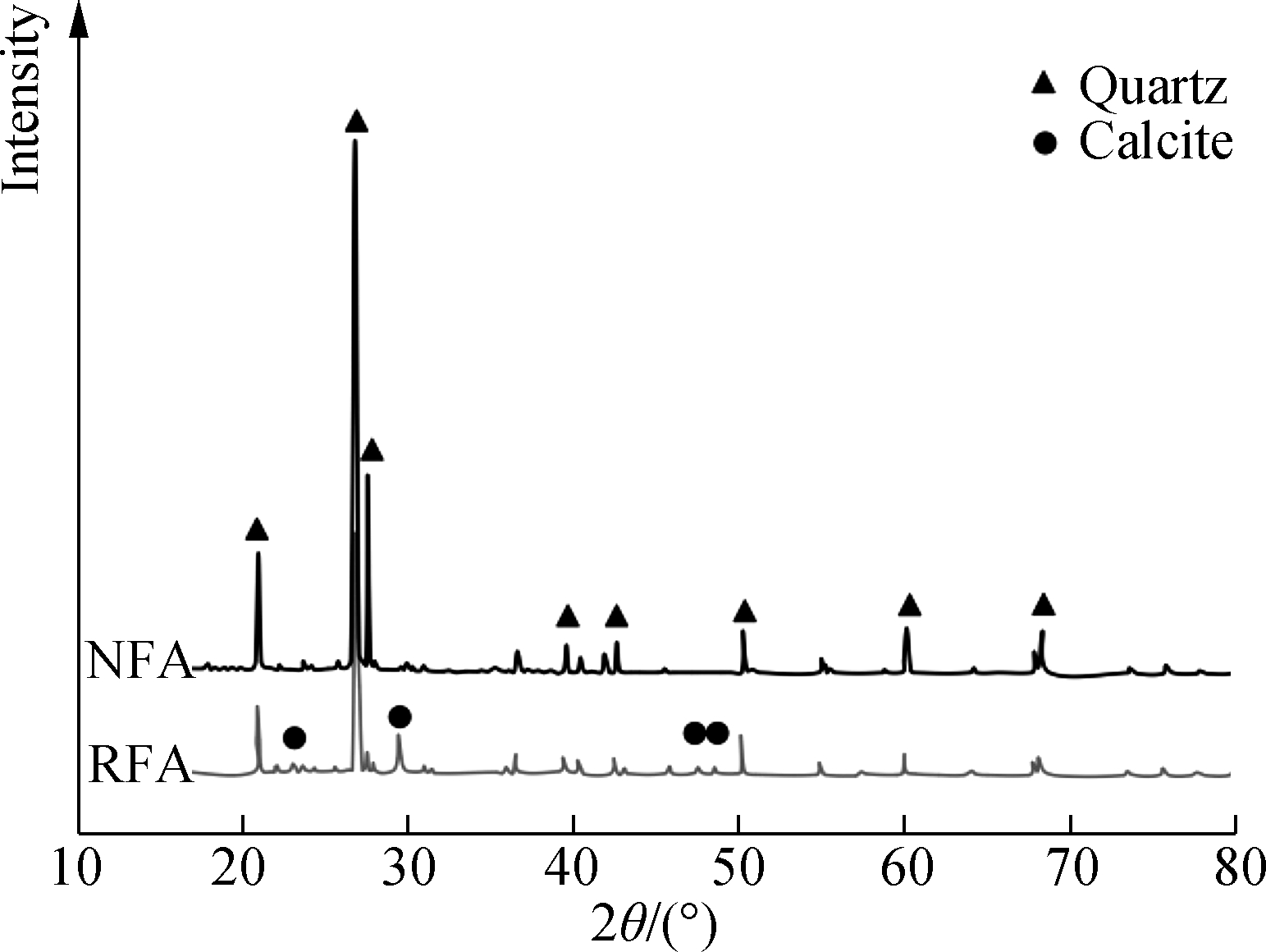
Fig.1 XRD patterns for fine aggregates
2.1.2 Physical properties
Fig.2 displays the physical properties of the fine aggregates. It is clear that the powder content of the RFA (14.2%) is higher than that of the NFA (2.0%) because the powders are attached to the aggregate during the crushing of CDW. In addition, the water absorption rate of the RFA is 2.66% higher than that of the NFA because more cracks exist in the RFA[2]. Moreover, the RFA shows a higher crush value, which can also be ascribed to the fact that the RFA has more micro-cracks compared with the NFA[2]. As a result, the RFA shows a lower strength, which increases its crush value.
2.2 Fresh mortar
2.2.1 Consistency
The consistency of fresh mortar is affected by three parameters: 1) The total amount of free water; 2) The rate between water and fine particle; and 3) The roughness of the aggregate surface[11]. Fig.3 displays the consistency values of the fresh mortars. It is evident that the consistency value of the RAM is lower than that of the REF by 3 mm, which is similar to the results obtained in a previous study[7]. This can be explained by two factors:1) The surface of the NFA is smoother than that of the RFA[2]; and 2) The micro powder content of the RFA is higher than that of the NFA (see Fig.2). Therefore, after all the NFAs are replaced by the RFAs, much free water is limited by the flocculate structures formed by micro powers because small particles can generate surface free energy[32].
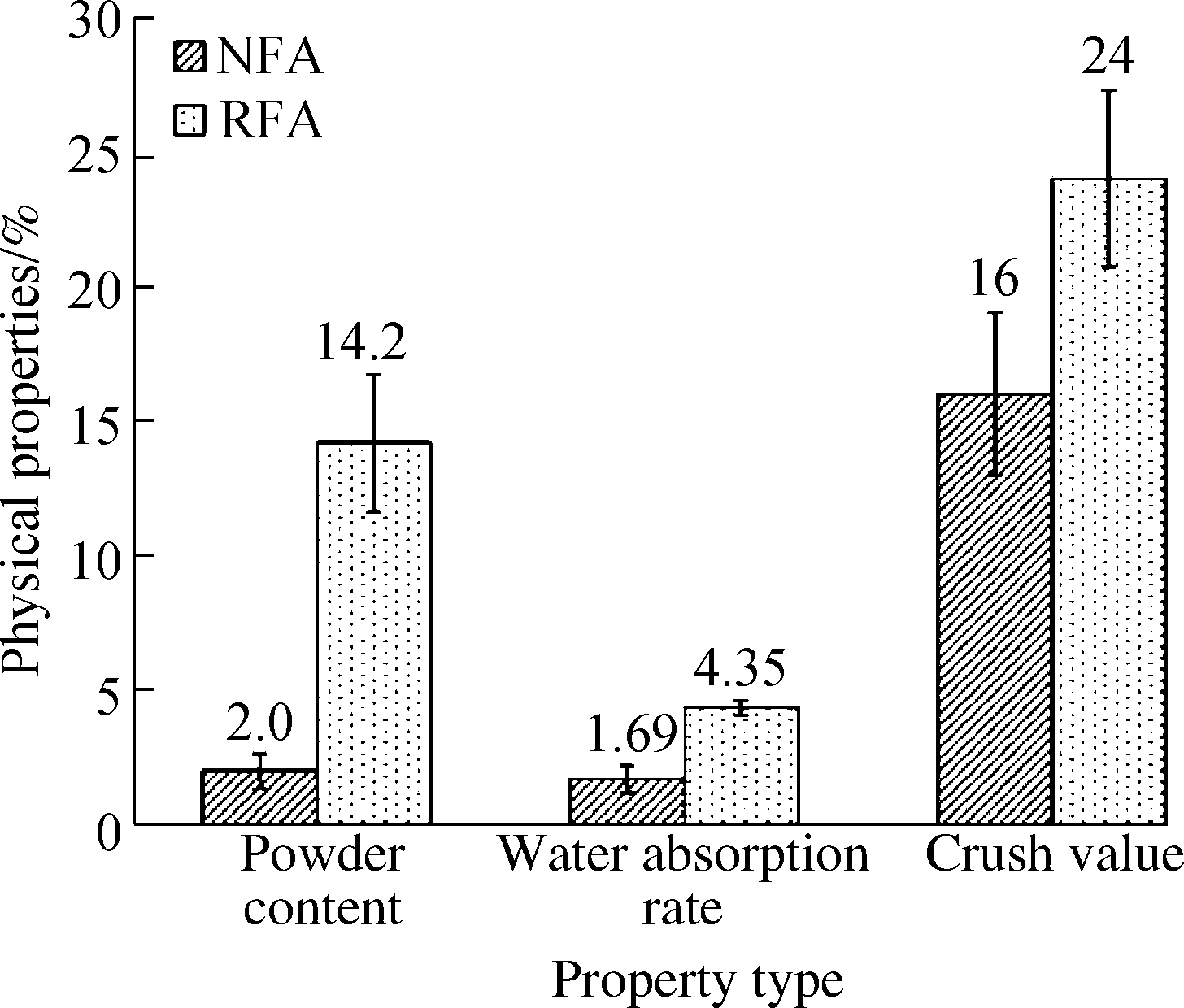
Fig.2 Physical properties of fine aggregates
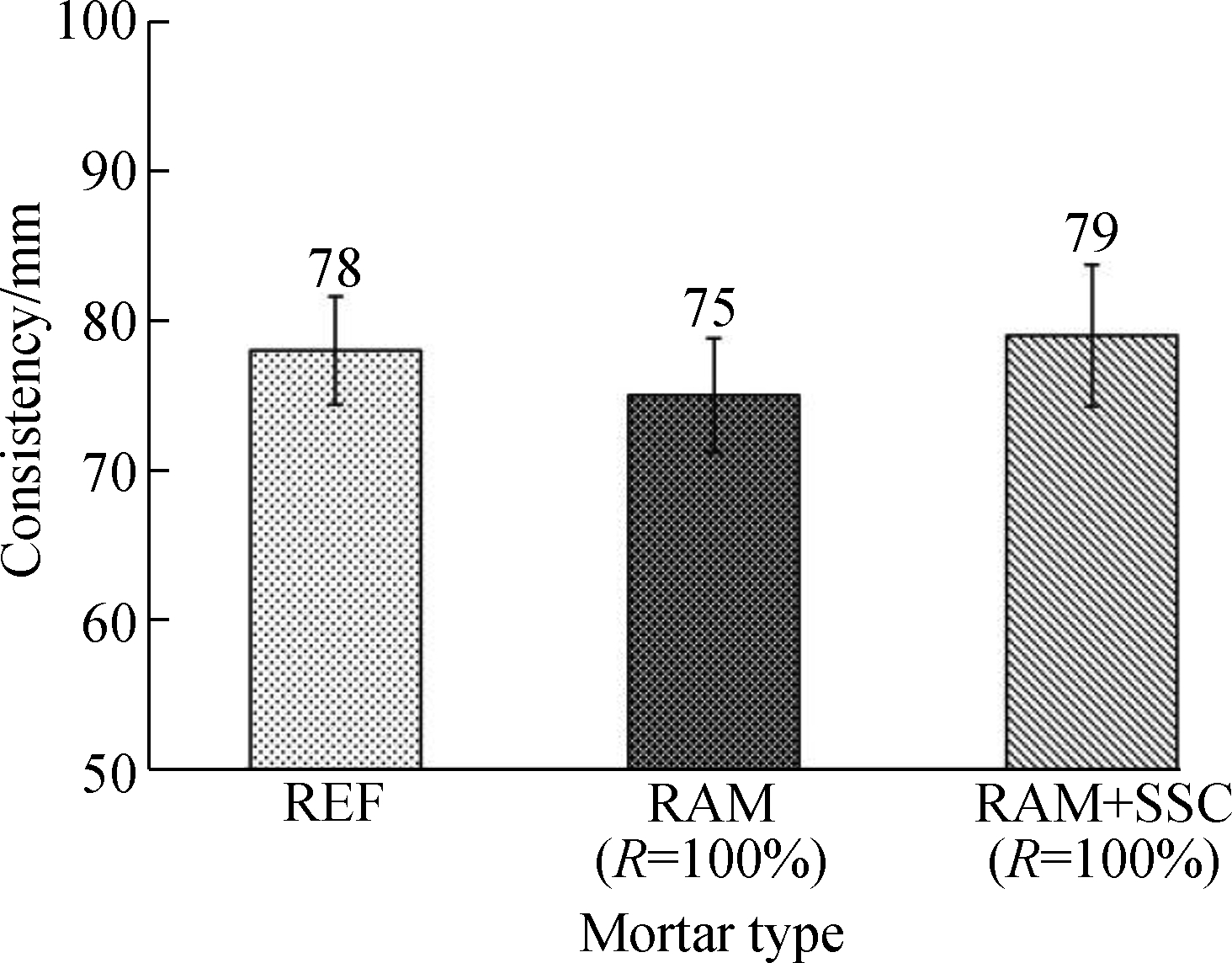
Fig.3 Consistency values of fresh mortars
Additionally, the consistency value of the RAM+SSC is higher than that of the RAM by 4 mm and similar to the value of the REF, which means that the SSC has some positive effects on the consistency of the RAM. This is because the amount of free water in the RAM+SSC is higher than that in the RAM because the SH and SL in the SSC can disperse the flocculate structures generated by micro powders[1315]. Thus, much free water is present in the RAM+SSC mixtures.
2.2.2 Water retention rate and consistency loss
Fig.4 depicts the water retention rates and consistency loss values of the fresh mortars. It is evident that the value of consistency loss of the RAM (50.0 mm) is higher than that of the REF (28.9 mm). A possible reason is that the water absorption rate of the RFA is higher than that of the NAF (see Fig.2). Interestingly, the water retention rate of the RAM (89.8%) is also higher than that of the REF (84.5%). This can also be attributed to the results of the water absorption rate.

Fig.4 Water retention rates and consistency loss values of fresh mortars
In terms of the RAM + SSC, their consistency loss value is similar to that of the REF. Due to the fact that the products generated by the complexation between the ingredients of the chemical admixture, the SH and CA in the SSC, and the Ca2+ in the cement are hydrophilic[13, 16], much water can remain in the mixtures instead of flowing out.
2.2.3 Density
Fig.5 presents the density values of the fresh mortars. It is evident that the density value of the RAM (1 890 kg/m3) is higher than that of the REF (1 830 kg/m3), which is in agreement with the result in Ref.[33]. This is because the water absorption rate of the RFA is higher than that of NFA (see Fig.2). As for the RAM+SSC, their density, which is similar to that of the REF, is lower than that of the RAM by 70 kg/m3 as the water-binder ratio is reduced by 0.2 (see Tab.4).
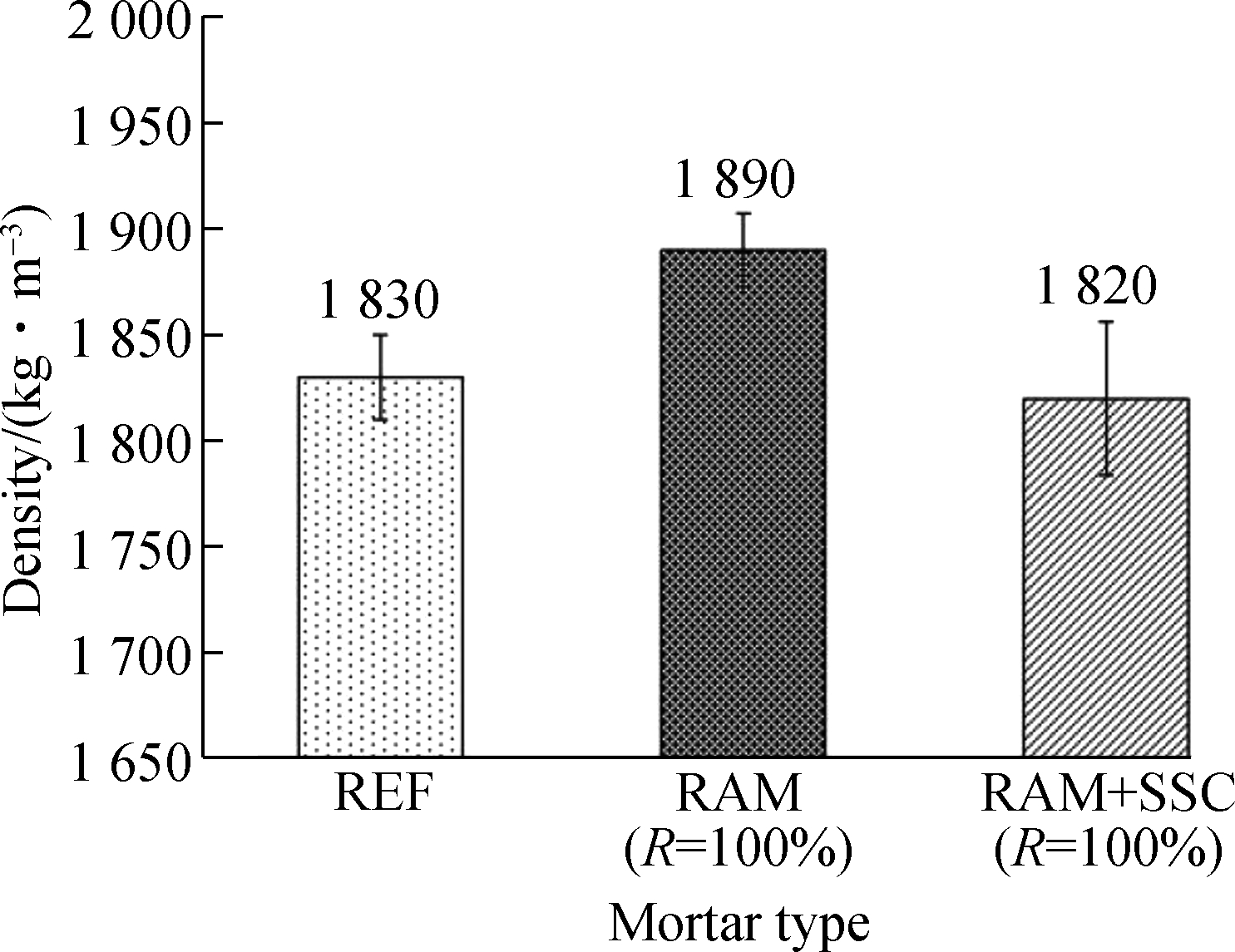
Fig.5 Density values of fresh mortars
2.3 Hardened mortar
2.3.1 Setting time
The setting time results of the hardened mortars are shown in Fig.6. It is evident that the setting time of the RAM (336 min) is lower than that of the REF (506 min), which is in agreement with the result in Ref.[11]. This behavior might be related to the fact that the high water-retention capacity (see Fig.4) allows the material to hold a large amount of free water during the mortar preparation[2]. As expected, its setting time of RAM+SSC increases by 225 min because the SH and CA in the SSC can retard the hydration of the cement particle[1314, 1617].

Fig.6 Setting time results of hardened mortars
2.3.2 Compressive strength
Fig.7 depicts the compressive strengths and effective water-binder rates (w/beff) of the hardened mortars. w/beff value can be calculated as
(1)
where m1, m2, and m3 are the weights of total water, aggregate and binding materials; and P is the water absorption rate of the aggregate after 24 h.
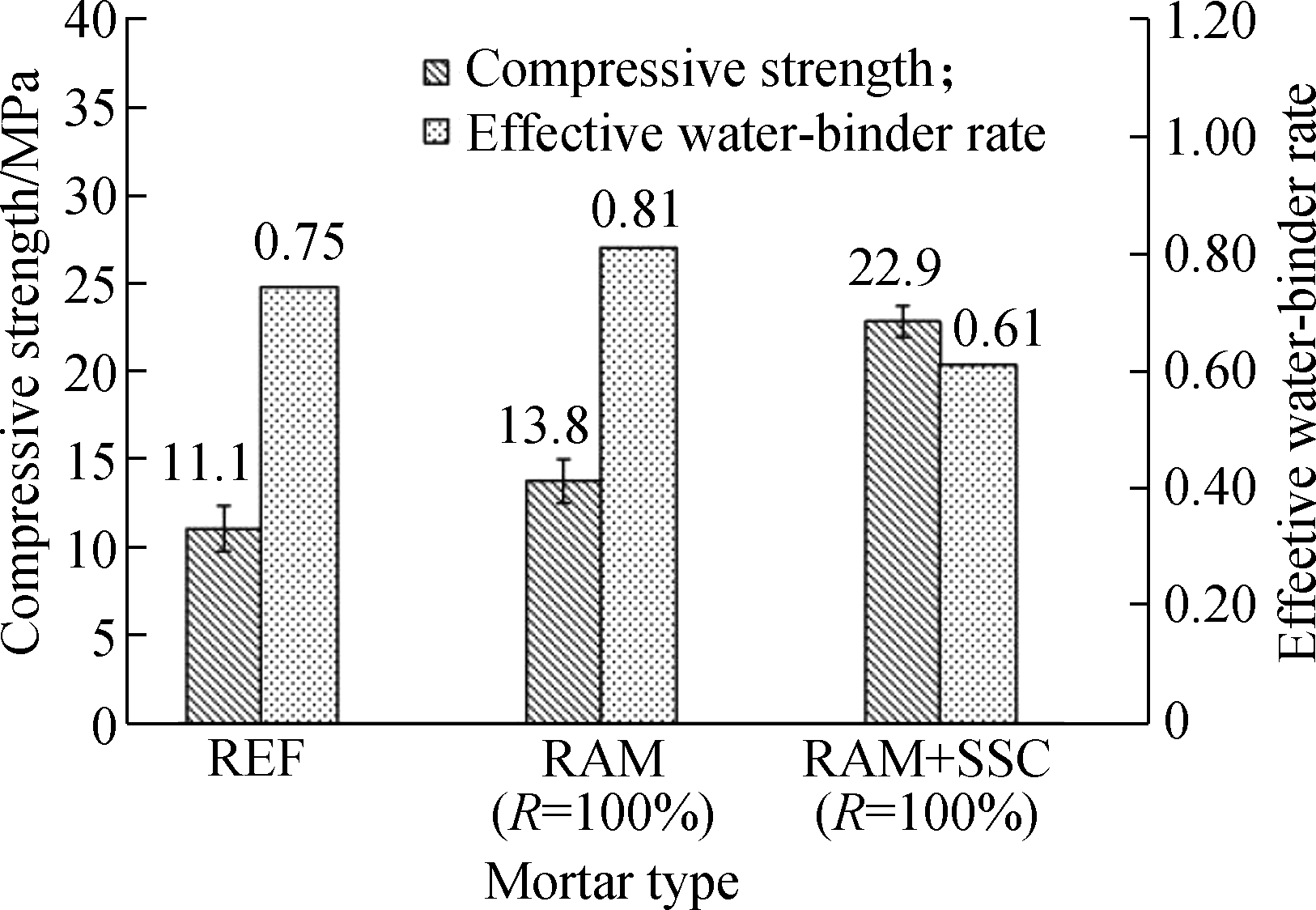
Fig.7 Compressive strengths and effective water-binder rates of hardened mortars
It is evident that the compressive strength of the RAM is higher than that of the REF, which is in agreement with the results of some previous studies[3435]. This phenomenon can be explained as follows: 1) The amount of water in the RFA is higher than that in the NFA because the RFA shows a higher water absorption rate compared with the NFA (see Fig.2), and the water provides an internal curing environment[2, 34]. This facilitates the dense combination with the set cement interface, so that the intensity between the RFA and set cement is significantly increased; and 2) More micro powders are present in the RFA, and these powders serve as filler materials, which decreases the porosity of the mortar[35].
In terms of the RAM+SSC, its compressive strength value is higher than that of the RAM by 9.1 MPa.This phenomenon can be explained as follows:1) The water retention rate of the RAM+SSC is higher than that of the RAM; therefore, much more water is present in the RAM+SSC offering an internal curing environment. 2) The incorporation of SH and SL in the SSC can not only disperse the micro powders in the mixtures and then help the powders more effectively fill into the pores of the cement paste, but also decreases the amount of flocculate structures generated by micro powders and then loosens much free water for cement hydration.
3 Conclusions
1) The consistency value of fresh recycled aggregate mortar (RAM) is lower than that of the reference mortar by 3 mm, whereas the values of consistency loss, water retention rate and density of the RAM are higher than those of the reference mortar by 21.1 mm, 5.3% and 50 kg/m3, respectively. After the admixture is added into the RAM, the consistency value increased by 4 mm, and the consistency loss and density values decreased by 21.1 mm and 70 kg/m3, respectively.
2) The setting time of hardened RAM is lower than that of the reference mortar by 170 min, but the compressive strength value of the RAM is higher than that of the reference mortar by 2.7 MPa. After the admixture is added into the RAM, the setting time and compressive strength increase by 225 min and 9.1 MPa, respectively.
3) Therefore, adding SSC into RAM is an effective and efficient way to expand its application, and future research should pay more attention to the effect of the admixture on the durability of RAM.
[1] Mi R J, Pan G H, Li Y, et al. Distinguishing between new and old mortars in recycled aggregate concrete under carbonation using iron oxide red[J].Construction and Building Materials, 2019, 222: 601609. DOI:10.1016/j.conbuildmat.2019.06.171.
[2] Pan G H, Zhan M M, Fu M H, et al. Effect of CO2 curing on demolition recycled fine aggregates enhanced by calcium hydroxide pre-soaking[J]. Construction and Building Materials, 2017, 154: 810818. DOI:10.1016/j.conbuildmat.2017.07.079.
[3] Zhan M M, Pan G H, Wang Y P, et al. Effect of presoak-accelerated carbonation factors on enhancing recycled aggregate mortars[J]. Magazine of Concrete Research, 2017, 69(16): 838849. DOI:10.1680/jmacr.16.00468.
[4] Liu Q, Xiao J Z, Sun Z H. Experimental study on the failure mechanism of recycled concrete[J]. Cement and Concrete Research, 2011, 41(10): 10501057. DOI:10.1016/j.cemconres.2011.06.007.
[5] Mi R J, Pan G H, Li Y, et al. Mathematical models for properties of mortars with admixtures and recycled fine aggregates from demolished concretes [J]. Journal of Southeast University (English Edition), 2018, 34: 371376.
[6] Mi R J, Pan G H, Li Y. Effects of admixtures and intensified aggregates on drying shrinkage of recycled aggregate mortars [J]. Journal of Southeast University (Natural Science Edition), 2018, 48: 363367. (in Chinese)
[7] Martínez I, Etxeberria M, Pavón E, et al. A comparative analysis of the properties of recycled and natural aggregate in masonry mortars[J]. Construction and Building Materials, 2013, 49: 384392. DOI:10.1016/j.conbuildmat.2013.08.049.
[8] Saiz Martínez P, González Cortina M, Fernández Martínez F, et al. Comparative study of three types of fine recycled aggregates from construction and demolition waste (CDW), and their use in masonry mortar fabrication[J]. Journal of Cleaner Production, 2016, 118: 162169. DOI:10.1016/j.jclepro.2016.01.059.
[9] Dapena E,Alaejos P, Lobet A, et al. Effect of recycled sand content on characteristics of mortars and concretes[J]. Journal of Materials in Civil Engineering, 2011, 23(4): 414422. DOI:10.1061/(ASCE)MT.19435533.0000183.
[10] Carasek H, GirardiI A C C, Araujo R C, et al. Study and evaluation of construction and demolition waste recycled aggregate for masonry and rendering mortar [J]. Cer mica, 2018, 64: 288300.
mica, 2018, 64: 288300.
[11] Katz A, Kulisch D. Performance of mortars containing recycled fine aggregate from construction and demolition waste[J]. Materials and Structures, 2017, 50(4): 199. DOI:10.1617/s11527-017-1067-x.
[12] Verian K P, Ashraf W, Cao Y Z. Properties of recycled concrete aggregate and their influence in new concrete production[J]. Resources, Conservation and Recycling, 2018, 133: 3049. DOI:10.1016/j.resconrec.2018.02.005.
[13] Tan H B, Zou F B, Liu M, et al. Effect of the adsorbing behavior of phosphate retarders on hydration of cement paste[J]. Journal of Materials in Civil Engineering, 2017, 29(9): 04017088. DOI:10.1061/(asce)mt.19435533.0001929.
[14] Bu Y H, Liu H J, Nazari A, et al. Amphoteric ion polymer as fluid loss additive for phosphoaluminate cement in the presence of sodium hexametaphosphate[J]. Journal of Natural Gas Science and Engineering, 2016, 31: 474480. DOI:10.1016/j.jngse.2016.03.062.
[15] Burgos-Montes O, Palacios M, Rivilla P, et al. Compatibility between superplasticizer admixtures and cements with mineral additions[J]. Construction and Building Materials, 2012, 31: 300309. DOI:10.1016/j.conbuildmat.2011.12.092.
[16] Singh N B, Singh A K, Prabha Singh S. Effect of citric acid on the hydration of Portland cement[J]. Cement and Concrete Research, 1986, 16(6): 911920. DOI:10.1016/0008-8846(86)90015-3.
[17] Ma B G, Xiao J Z, Tan H B. Effect of citric acid on cement hydration [C]//International Conference on Biotechnology, Chemical and Materials Engineering. Kunming, China, 2012: 4953.
[18] General Administration of Quality Supervision, Inspection and Quarantine of the People’s Republic of China. GB 175—2007 Common Portland cement [S]. Beijing: Standards Press of China, 2007. (in Chinese)
[19] General Administration of Quality Supervision, Inspection and Quarantine of the People’s Republic of China. GB/T 1596—2005 Fly ash used for cement and concrete [S]. Beijing: Standards Press of China, 2005. (in Chinese)
[20] Fu M H. Investigation on modifications and applications of recycled fine aggregate prepared from demolition concrete [D]. Nanjing: Southeast University, 2016. (in Chinese)
[21] Yang W K. The issues and discussion of modern concrete science[M]. Berlin: Springer, 2015: 210. DOI:10.1007/978-3-662-44567-9.
[22] Pereira P,Evangelista L, de Brito J. The effect of superplasticizers on the mechanical performance of concrete made with fine recycled concrete aggregates[J]. Cement and Concrete Composites, 2012, 34(9): 10441052. DOI:10.1016/j.cemconcomp.2012.06.009.
[23] Bravo M, de Brito J, Evangelista L, et al. Superplasticizer’s efficiency on the mechanical properties of recycled aggregates concrete: Influence of recycled aggregates composition and incorporation ratio[J]. Construction and Building Materials, 2017, 153: 129138. DOI:10.1016/j.conbuildmat.2017.07.103.
[24] Bravo M, de Brito J, Evangelista L, et al. Durability and shrinkage of concrete with CDW as recycled aggregates: Benefits from superplasticizer’s incorporation and influence of CDW composition[J]. Construction and Building Materials, 2018, 168: 818830. DOI:10.1016/j.conbuildmat.2018.02.176.
[25] Ministry of Housing and Urban-Rural Development of the People’s Republic of China. JG/JT 98—2011 Specification for mix proportion design of masonary mortar [S]. Beijing: Standards Press of China, 2011. (in Chinese)
[26] General Administration of Quality Supervision, Inspection and Quarantine of the People’s Republic of China. GB/T 25176—2010 Recycled fine aggregate for concrete and mortar [S]. Beijing: Standards Press of China, 2010. (in Chinese)
[27] General Administration of Quality Supervision, Inspection and Quarantine of the People’s Republic of China. GB/T 14684—2011 Sand for construction [S]. Beijing: Standards Press of China, 2011. (in Chinese)
[28] General Administration of Quality Supervision, Inspection and Quarantine of the People’s Republic of China. GB/T 25181—2010 Ready-mixed mortar [S]. Beijing: Standards Press of China, 2010. (in Chinese)
[29] Ministry of Housing and Urban-Rural Development of the People’s Republic of China. JGJ/T 70—2009 Standard for test method of basic properties of construction mortar [S]. Beijing: Standards Press of China, 2009. (in Chinese)
[30] Mi R J, Pan G H, Shen Q Z. Carbonation modelling for cement-based materials considering influences of aggregate and interfacial transition zone[J]. Construction and Building Materials, 2019, 229: 116925. DOI:10.1016/j.conbuildmat.2019.116925.
[31] Mi R J, Pan G H, Liew K M. Predicting carbonation service life of reinforced concrete beams reflecting distribution of carbonation zones[J]. Construction and Building Materials, 2020, 255: 119367. DOI:10.1016/j.conbuildmat.2020.119367.
[32] Diamond S. The micro-structures of cement paste in concrete [C]//8th International Congress on the Chemistry of Cement. Rio de Janeiro, Brazil, 1986: 122147.
[33] Braga M,de Brito J, Veiga R. Incorporation of fine concrete aggregates in mortars[J]. Construction and Building Materials, 2012, 36: 960968. DOI:10.1016/j.conbuildmat.2012.06.031.
[34] Dang J T, Zhao J, Hu W Y, et al. Properties of mortar with waste clay bricks as fine aggregate[J]. Construction and Building Materials, 2018, 166: 898907. DOI:10.1016/j.conbuildmat.2018.01.109.
[35] Sun Z H, Liu F J, Tong T, et al. Hydration of concrete containing hybrid recycled demolition powders[J]. Journal of Materials in Civil Engineering, 2017, 29(7): 04017037. DOI:10.1061/(asce)mt.19435533.0001842.